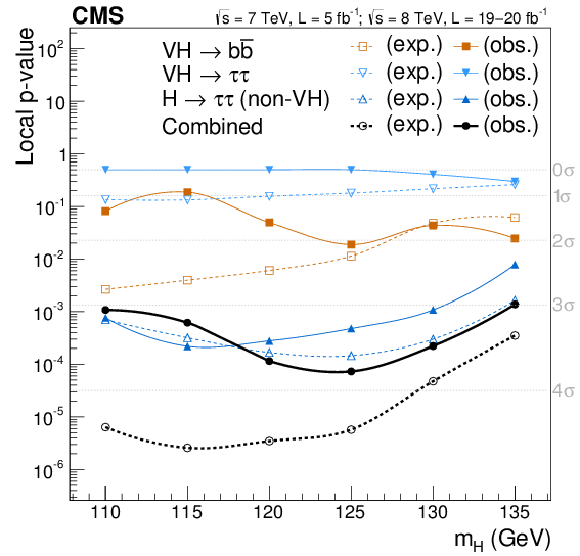

Compact Muon Solenoid
LHC, CERN
| CMS-HIG-13-033 ; CERN-PH-EP-2014-004 | ||
| Evidence for the direct decay of the 125 GeV Higgs boson to fermions | ||
| CMS Collaboration | ||
| 24 January 2014 | ||
| Nature Phys. 10 (2014) 557-560 | ||
|
Abstract:
The discovery of a new boson with a mass of approximately 125 GeV in 2012 at the LHC has heralded a new era in understanding the nature of electroweak symmetry breaking and possibly completing the standard model of particle physics. Since the first observation in decays to gamma-gamma, WW, and ZZ boson pairs, an extensive set of measurements of the mass and couplings to W and Z bosons, as well as multiple tests of the spin-parity quantum numbers, have revealed that the properties of the new boson are consistent with those of the long-sought agent responsible for electroweak symmetry breaking. An important open question is whether the new particle also couples to fermions, and in particular to down-type fermions, since the current measurements mainly constrain the couplings to the up-type top quark. Determination of the couplings to down-type fermions requires direct measurement of the corresponding Higgs boson decays, as recently reported by the CMS experiment in the study of Higgs decays to bottom quarks and tau-leptons. In this paper we report the combination of these two channels which results, for the first time, in strong evidence for the direct coupling of the 125-GeV Higgs boson to down-type fermions, with an observed significance of 3.8 standard deviations, when 4.4 are expected. This paper is dedicated to our dear colleague and friend Professor Lorenzo Foà who passed away on January 13, 2014. Lorenzo's contribution to CMS was unique and left an indelible impact on the experiment in all its phases: Lorenzo was the CMS principal referee in the CERN LHC Committee during the approval process, initiated the participation of many groups during the formation of the CMS Collaboration, provided prescient advice and guidance during his period as CERN Director of Research, was Chair of the CMS Collaboration Board during the critical phase of construction, and was the first Chair of the Thesis Award Committee enabling him to stay close to young physicists. | ||
| Links: e-print arXiv:1401.6527 [hep-ex] (PDF) ; CDS record ; inSPIRE record ; Public twiki page ; CADI line (restricted) ; | ||
| Figures | |

png pdf |
Figure 1:
The $p$-value for the background-only hypothesis as a function of the Higgs boson mass hypothesis for both the observed data (obs.) and pseudo-data constructed using the median expectation for the standard model Higgs boson after the signal-plus-background fit to the data (exp.). To help visualize the results, smooth lines connect the points at which the probabilities are evaluated. The H $\rightarrow {\tau } {\tau }$ analysis results are broken down into a contribution from VH $\rightarrow {\tau } {\tau } $ categories, which share the production process with the V H $ \rightarrow { {\mathrm {b}} {\overline {\mathrm {b}}}} $ analysis, and another contribution with all other H ${ \rightarrow {\tau } {\tau }} $ event categories. For every mass hypothesis tested, the non-fermionic decay contributions are taken to be those of the standard model Higgs boson with a mass of 125 GeV. Non-fermionic decays are considered as part of the background and consequently do not contribute to the measurement. |

png pdf |
Figure 2:
Scan of the profile likelihood as a function of the signal strength relative to the expectation for the production and decay of a standard model Higgs boson, $\mu $, for $ {m_{ {\mathrm {H}} }} $ =125 GeV. The statistical significance against the background-only ($\mu =0$) hypothesis is shown for the two channels and their combination. By definition, the expectation for the standard model Higgs boson with a mass of 125 GeV is $\mu =1$. The non-fermionic decay contributions expected for the standard model Higgs boson with a mass of 125 GeV are considered as part of the background and therefore not scaled with $\mu $. |

|
Compact Muon Solenoid LHC, CERN |

|

|

|

|

|

|